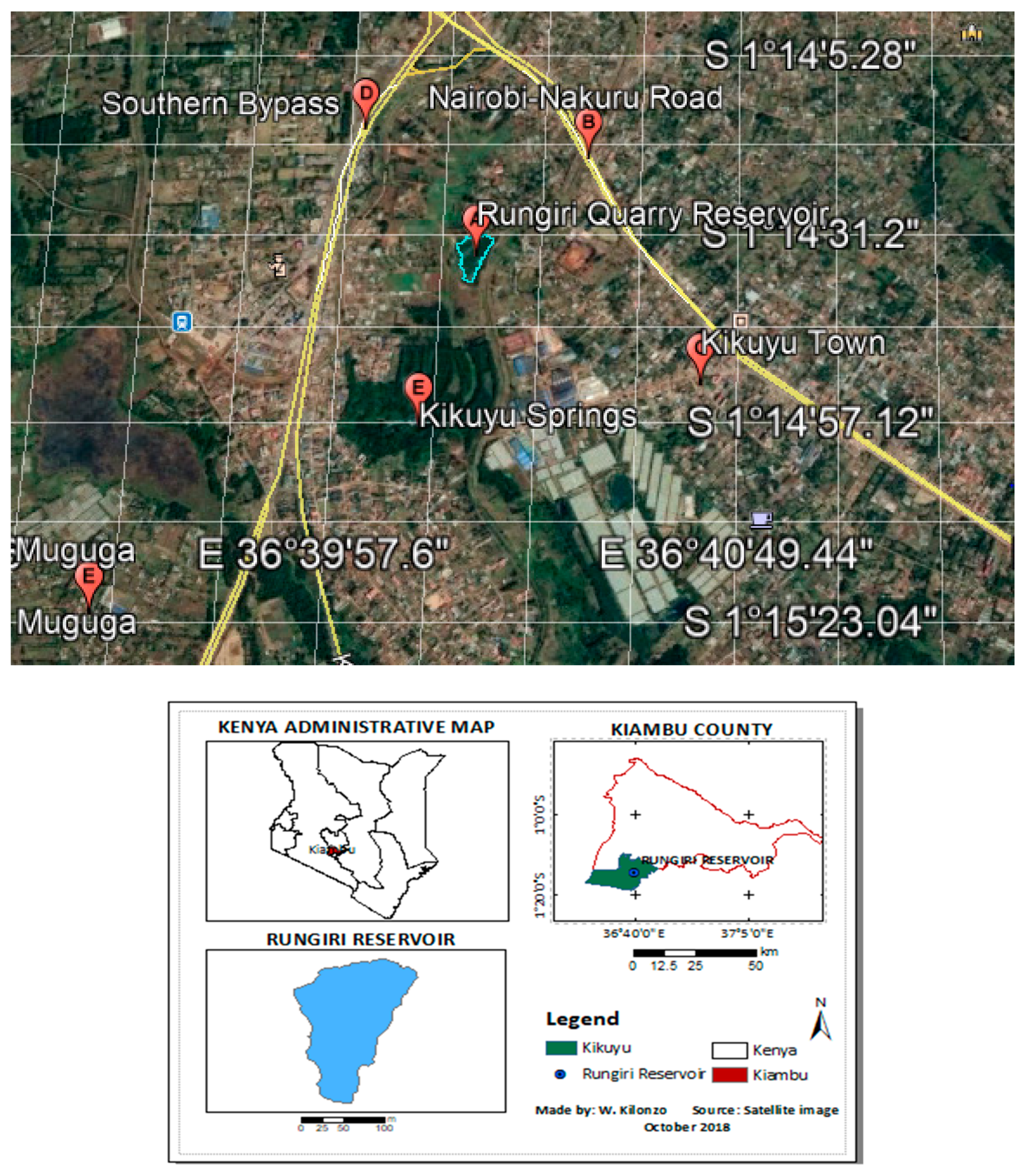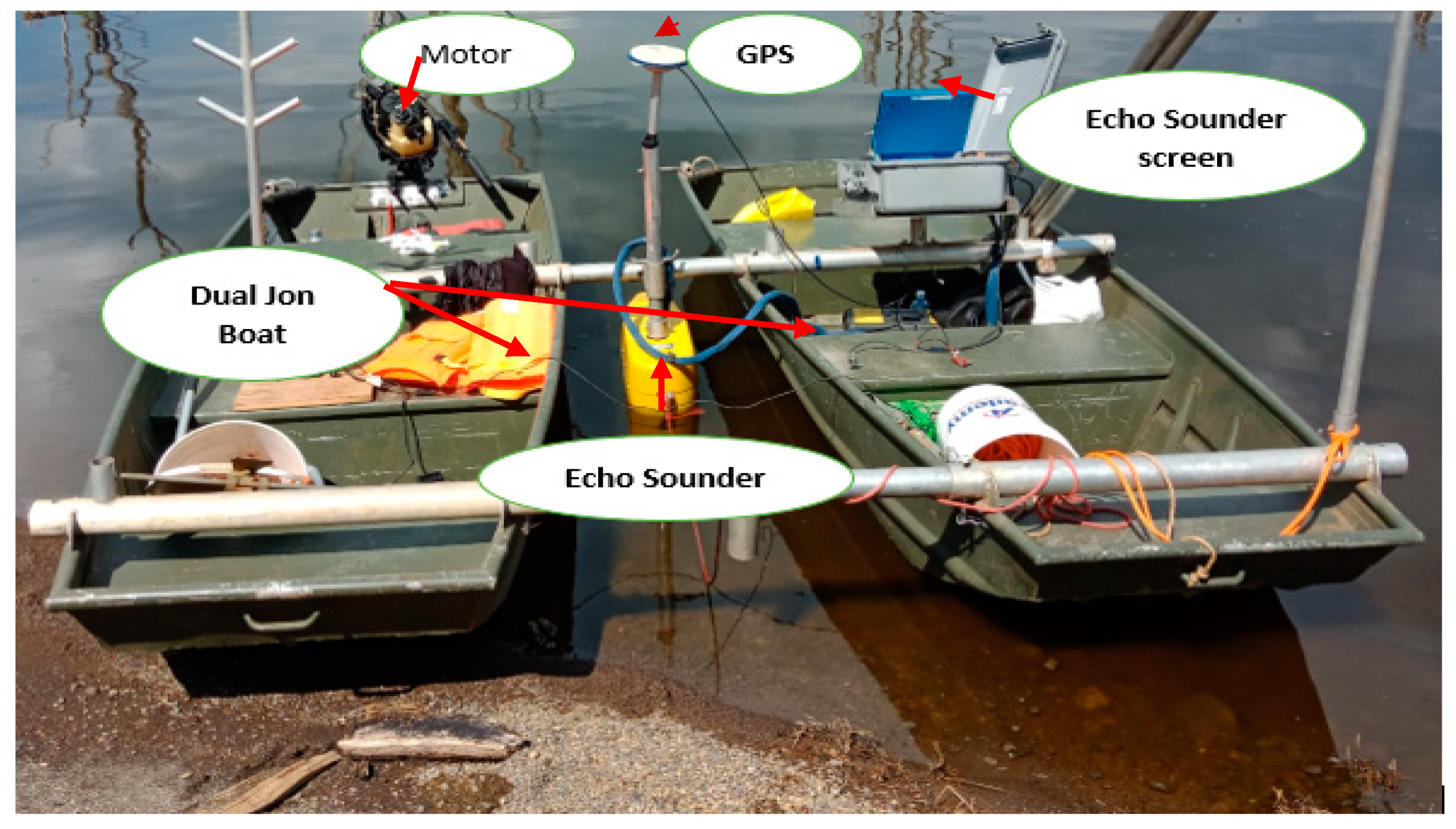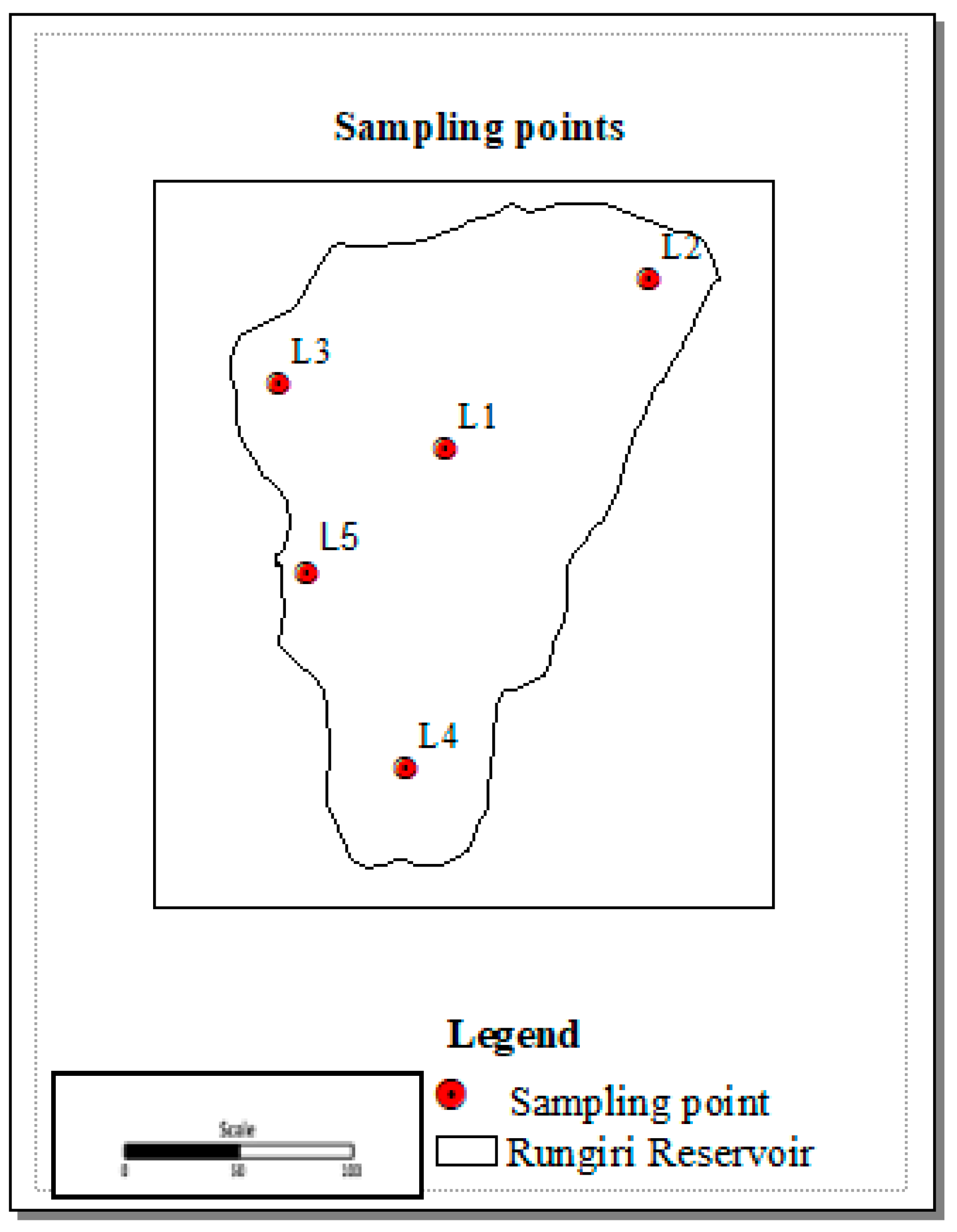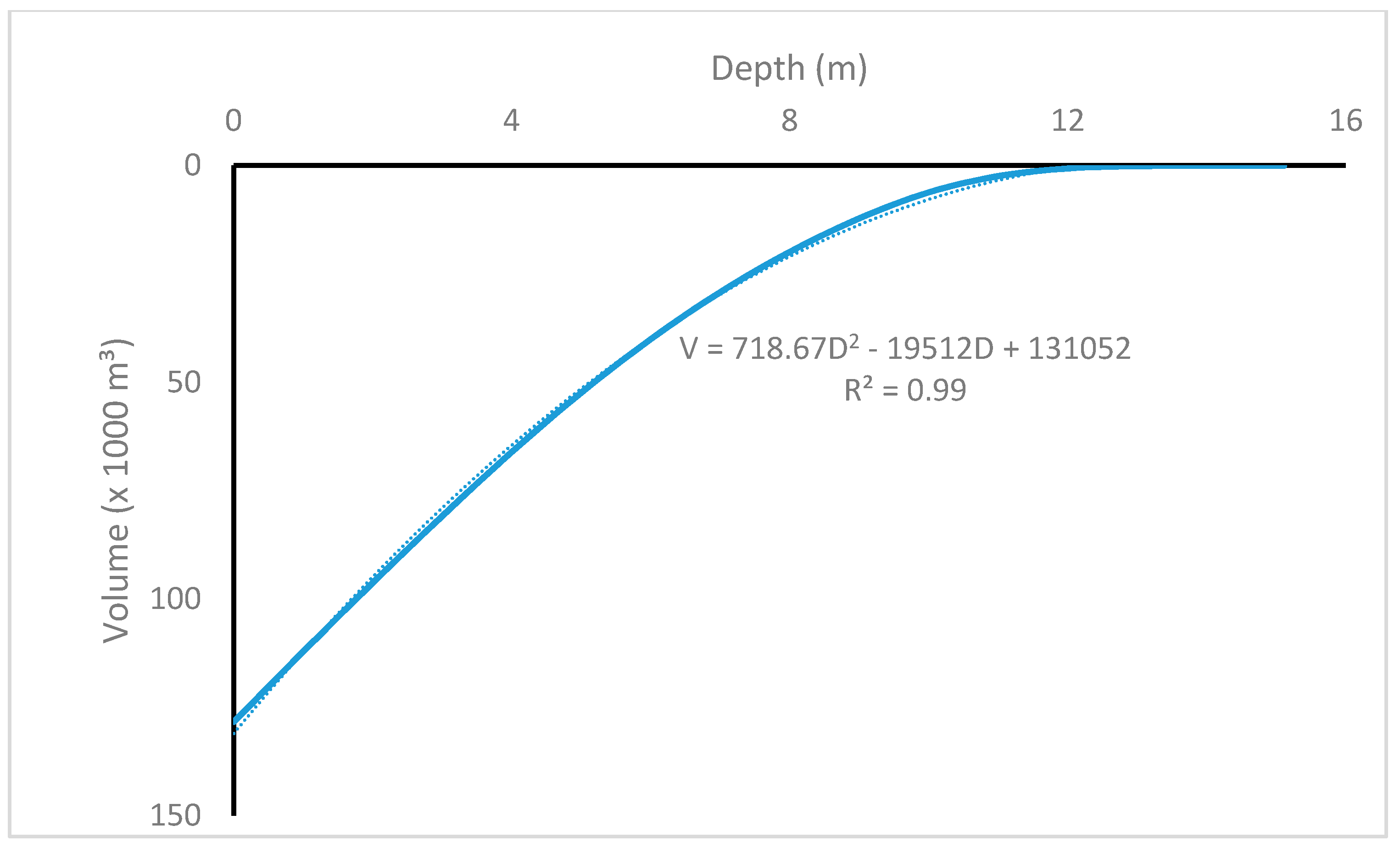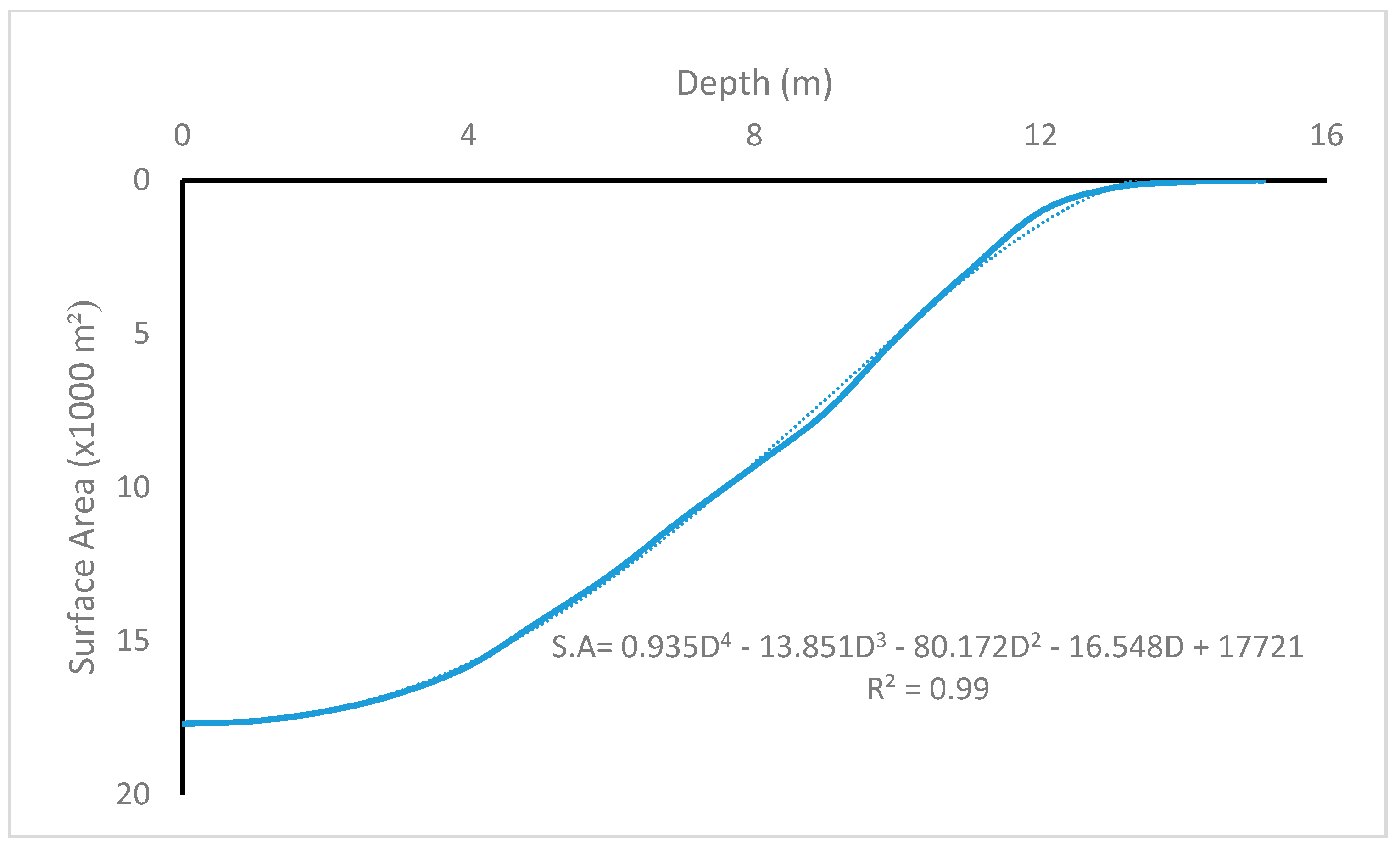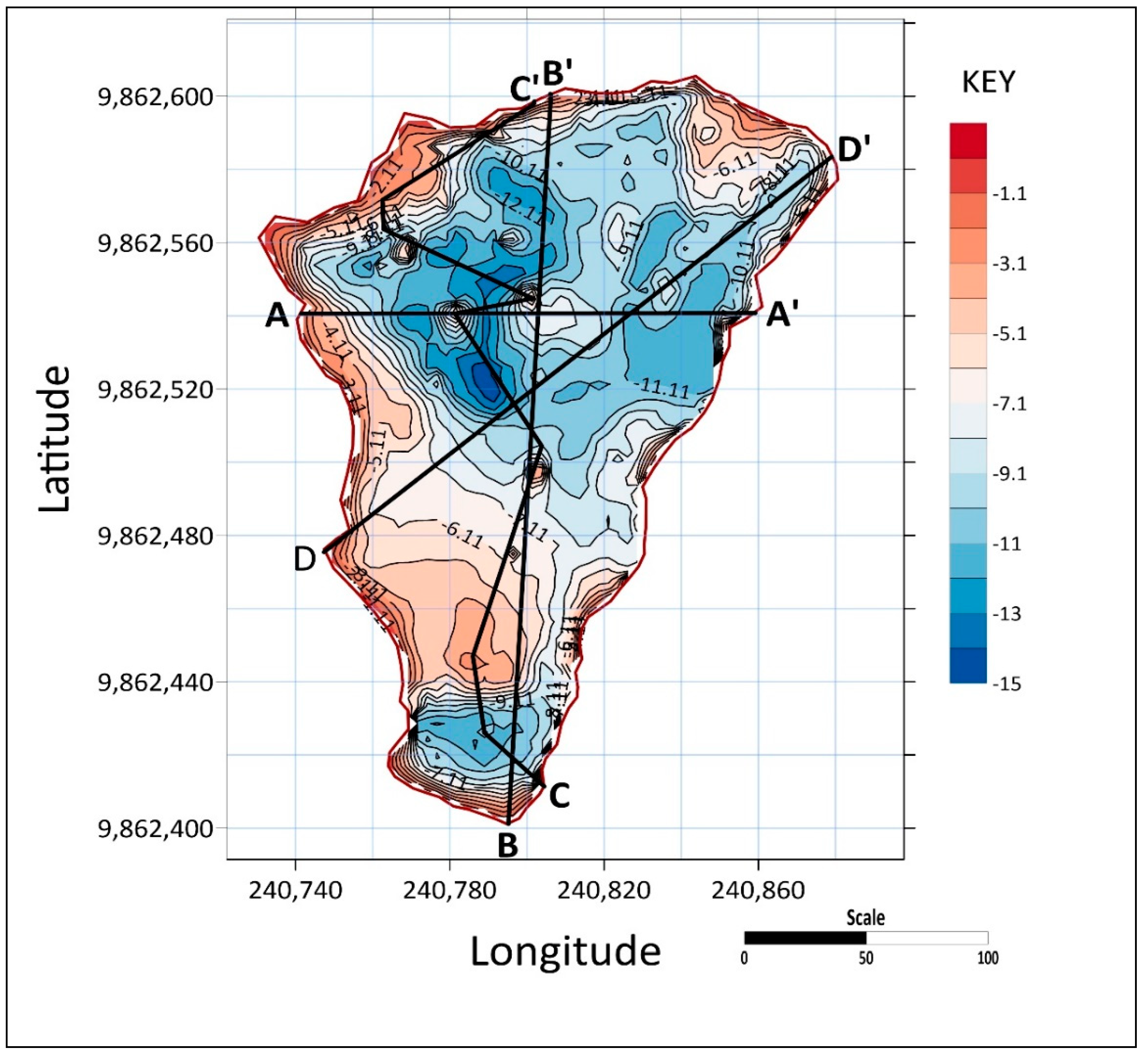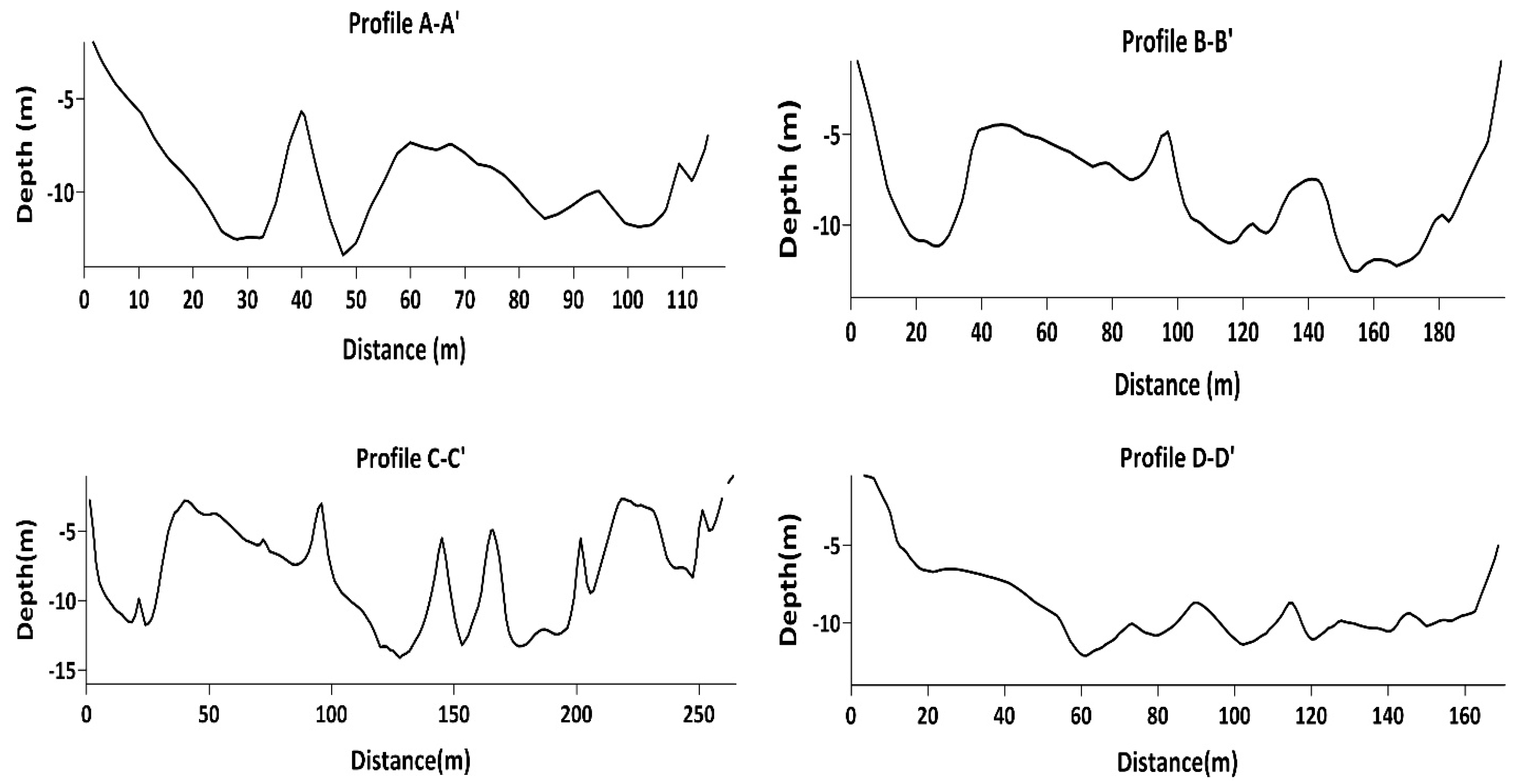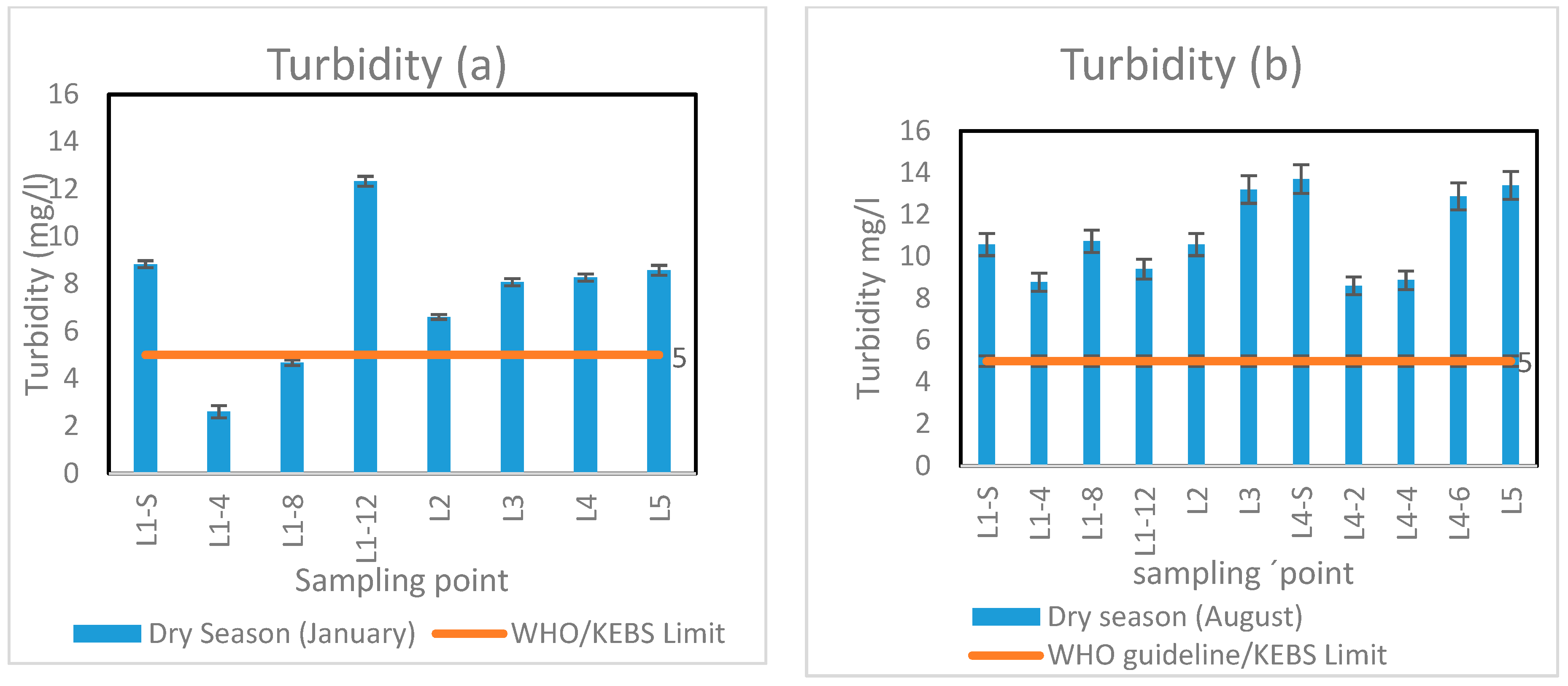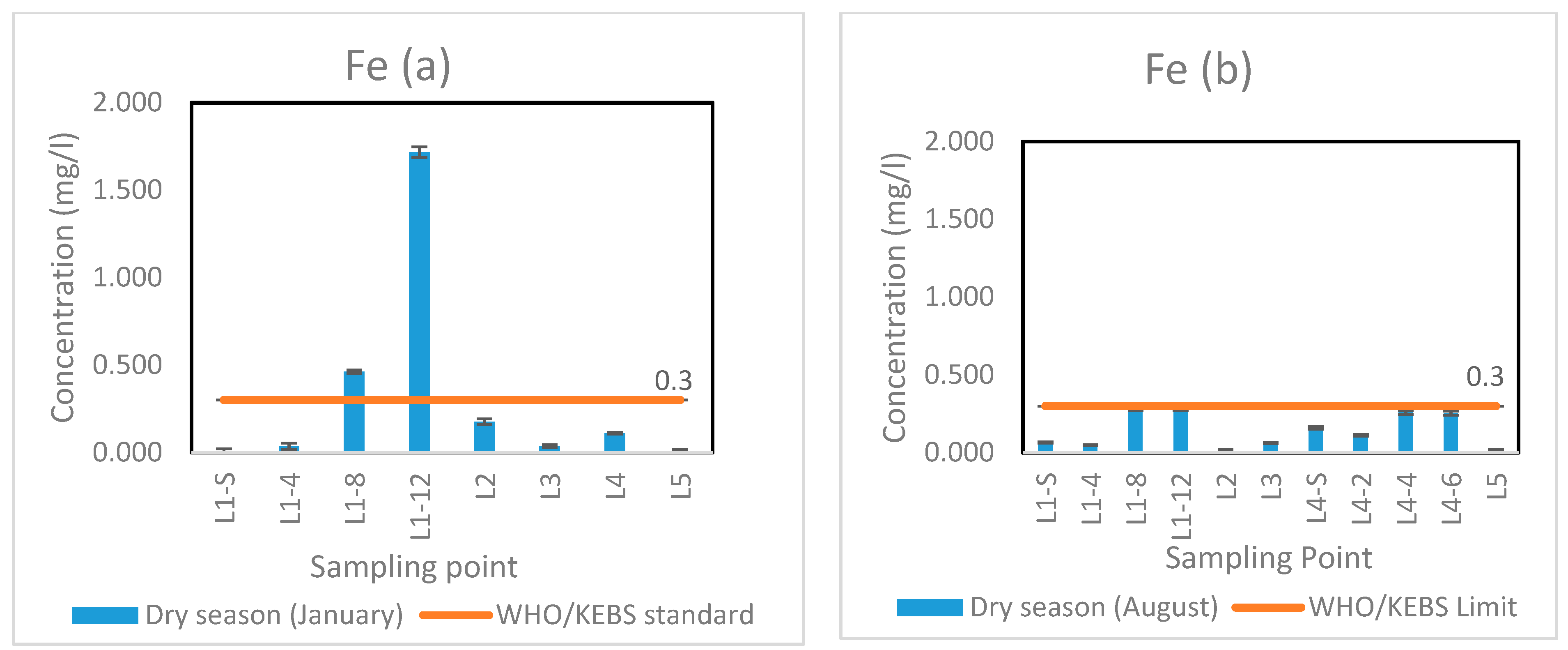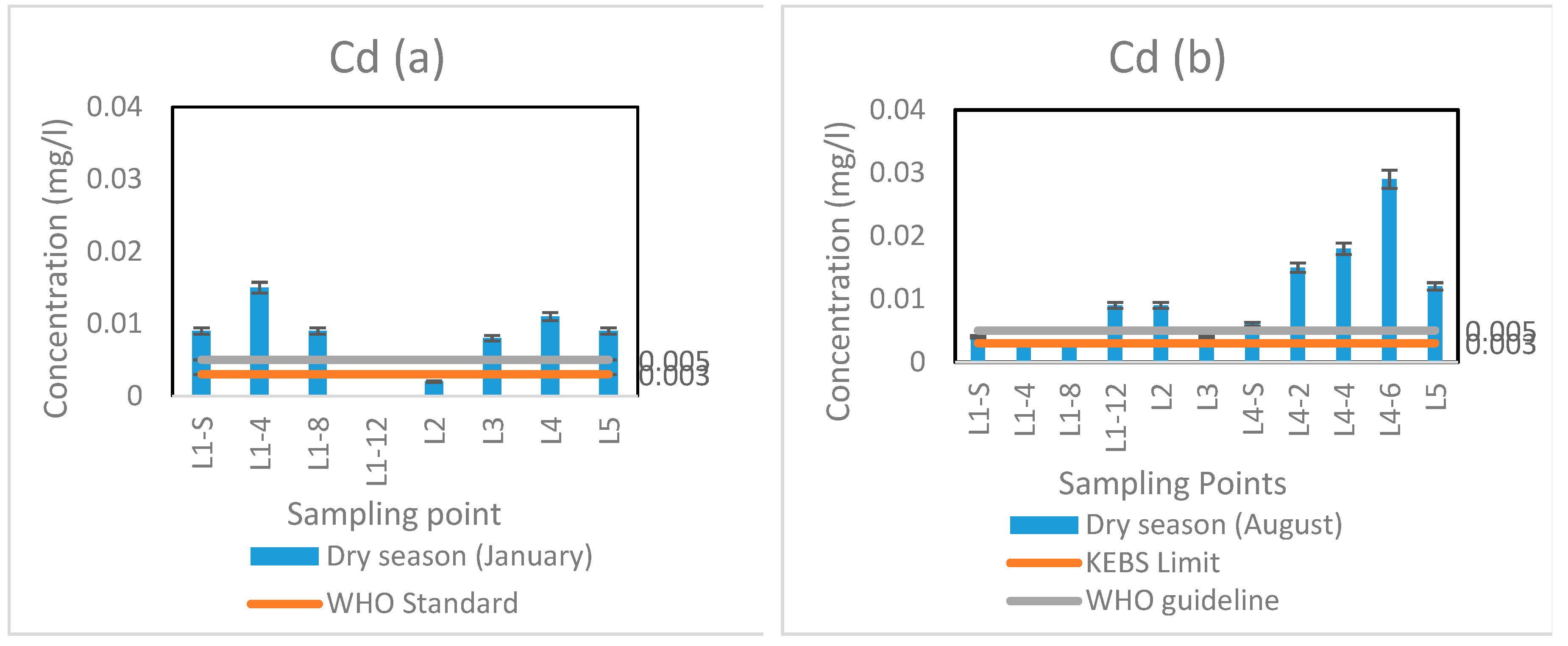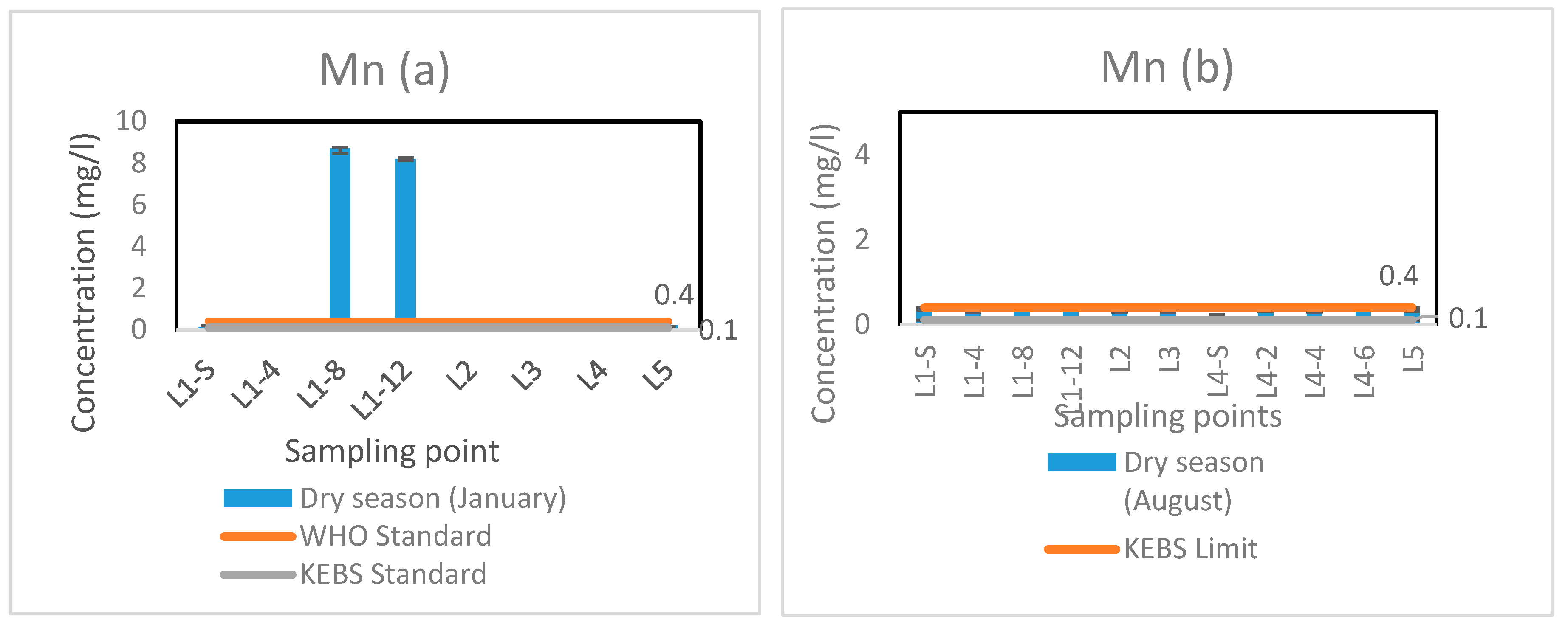1. Introduction
Urbanization has led to constraint of water resources, while climate change has reduced amounts of surface water in some parts of the world [
1]. Normally, underground mine galleries and open-pit mines are flooded by natural groundwater, surface water inflow, and water pumped from dewatering systems, and can therefore be used as strategic reservoirs for water storage. Depending on its quality and intended purpose, water is treated using appropriate technology to meet different needs [
1]. Water in quarry reservoirs can be used for irrigation, domestic supply, industrial supply, and aquifer recharge, amongst other uses [
2]. The Hallett quarry gravel pit lake system in Ames City, Iowa, United States, is one of the quarry pits that was assessed for water storage and domestic supply to the city [
3]. The quarry pit system water was analyzed together with the effect of storm water. The water quality was found to be of similar quality when compared to other water bodies in Iowa. Storm water elevated concentration of parameters such as fecal coliforms in the quarry pit system [
3]. Bellwood quarry in Atlanta, Georgia, is also used for raw water storage to supplement existing water supply [
4]. Kikuyu sub-county in Kiambu county, Kenya, has few surface water resources and mostly relies on groundwater resources [
5]. Kikuyu Water Company, which is mandated to supply water to the sub-county, is not able to meet the current water demand. According to a report on the performance of Kenya’s water service sector, only 202,582 persons out of a total population of 318,557 persons within the company’s mandated area are being supplied with water by the company [
6]. The water demand in Kikuyu in 2015 was 2972 m
3/day and was projected to be 3834 m
3/day in 2025. It is, therefore, important to exploit any possible sources of water in the area to ease the current and future water demand. Small reservoirs have been neglected in hydrological research. They receive less attention and lack management strategies, while large reservoirs are well managed and monitored [
7]. Rungiri quarry reservoir, whose storage capacity and water quality is unknown, could be a potential source of water for the neighbouring community. The reservoir is 2.5 km from Kikuyu town, which Kikuyu Water Company solely supplies water to. The reservoir was formed in 1992 during quarrying of trachyte for road construction as a result of puncturing a ground water aquifer, and has been used for irrigation ever since, with the excess water being unutilized [
8]. The other natural water body within the area is Kikuyu springs, which is currently under development to supply water to Kikuyu town and its environs. Rungiri quarry reservoir is a potential source. The water source is purely ground water. The county government of Kiambu is interested in the reservoir for domestic water supply, so the results of this study will be timely.
Knowledge of available water in reservoirs guides stakeholders and managers in determining sustainable exploitation plan of the reservoirs [
9]. Water body morphometry parameters provide information to assess residence time, life expectancy, water balance, sustainable water abstraction, and derivation of stage curves [
10]. Some of the methods used to assess storage capacities of reservoirs are bathymetry surveys. Bathymetry refers to depths and shapes of underwater terrain [
11]. There are different methods used to generate bathymetric information, such as spatial interpolation methods based on collected depth samples, topographic-data-based methods, and remote-sensing-based methods. Spatial interpolation methods are the most frequently used to obtain bathymetric information [
12]. Topographic-data-based methods allow mapping of the bathymetry of reservoirs easily compared to the other methods; however, the topographic data must be collected before filling the reservoir, and these kinds of data are not always available. Remote sensing-based methods have advantages in terms of the coverage of large areas and data collection in areas with limited access. Remote-sensing-based methods are limited by the water transparency, the depth of the reservoir, and meteorological conditions [
12]. However, remote sensing by light detection and ranging (LIDAR) and bathymetry survey by use of an acoustic profiling system (APS) offer comparable accuracy [
13]. To ensure proper coverage of a water body in a bathymetry survey, APS is used. LIDAR may offer comparable accuracy to bathymetry survey but is expensive, equipment intensive, and time consuming [
13,
14] Bathymetric survey by use of APS is a fast and low cost methodology that gives detailed information on water depths, surface areas, and reservoir depth-volume relationships by use of sound in measurement of water depths. This technique has been used globally to avail data for volume computation of water in reservoirs, generation of depth contour maps, and underwater morphology. By using APS, water depth information in the form of x, y, z coordinates is obtained by conducting a sequence of cross-sectional surveys in the water body along multiple transects [
15].
Similar surveys have been done in the Peechi reservoir, Ruiru reservoir, and lake Naivasha [
9,
11,
16] Bathymetric maps, storage capacities, and morphometric characteristics of Lake Hayq in Ethiopia were generated to provide scientific information for use in reservoir management [
10]. Bathymetry survey data was used to estimate storage capacities of small reservoirs in the upper-eastern region of Ghana [
17,
18,
19,
20]. Hydrographic surveys for sea beds and lakes provide key information on morphology of waterbodies However, use of APS in bathymetry surveys makes it challenging to obtain depth measurements at depths of less than 50 cm. Regions of lower depth are not surveyed but are generated with interpolation techniques or direct measurement of water depth [
9]. Techniques used for interpolation of bathymetry survey data include triangulated irregular network (TIN) model, nearest-neighbor interpolation, kriging interpolation method, inverse distance interpolation, and polynomial interpolation. Kriging method is the most suitable for interpolating single-beam data [
18], and according to [
10], the kriging interpolation method produces visually appealing maps by reducing interpolation errors. A study done to compare different spatial interpolation methods for historical hydrographic data of the lowermost Mississippi river by [
15] concluded that ordinary kriging performed best in mapping the bathymetry of the river.
The methodology was developed specifically for reservoirs. For this particular case, it was applied to a quarry and utilized in determination of precise depth and geographical coordinates of water sample collection points in both January and August, unlike in the previous studies.
Providing safe drinking water to the population is one of Kenya’s Vision 2030 goals. Safe drinking water is not only important for health, but has a considerable role in development at national, regional, and local levels. Investment in water supply and sanitation yield a net economic benefit [
21].
Water quality directly affects water purification and treatment costs [
22], hence making it an important part of water supply functionality. The main reasons for testing water quality is the need to assess various parameter statuses against existing standards and to verify whether the observed water quality is suitable for prospective uses. The level of contamination necessary to render a water body impaired is highly dependent on the type of water body, location, and the types of beneficial uses it supports [
23]. Surface water is affected by weathering of rocks, erosion, decay of organic matter, industrial and domestic water waste, agricultural runoff containing fertilizers, pesticides, and herbicides, and thermal wastes [
24]. For instance, heavy metal contamination in non-industrial or agricultural catchment setups contain metals in their geochemical background level or can be slightly contaminated [
25]. For health purposes, drinking water parameters should be within the standards set by Kenya Bureau of Standards (KEBS) and World Health Organization (WHO) guidelines to ensure safety.
Parameter quality when compared with guideline values indicates the acceptability of that specific parameter. The Water Quality Index (WQI), on the other hand, describes the influence of water quality parameters on the overall quality of water [
26]. Unlike the traditional methods, where an individual water quality parameter is compared with its standard limit with no depiction of water quality status [
27], the WQI reduces the large amounts of information to a single number, which reflects the composite influence of various quality parameters on the overall quality of water [
28]. It is utilized when surveying the general water quality by utilizing a finite scale to differentiate between polluted water and very clean water [
29]. WQI gives important data on the general water quality status, which can help in choosing a suitable water treatment technique [
28]. Models are also efficient tools, especially in forecasting water quality parameters in water bodies. Examples of these models are ensemble models and machine learning models, which are either data-driven models or physically based models [
30,
31]. However, modelling and forecasting of water quality is a complex procedure because of the nonlinear relationship of the variables [
31].
The WQI was first introduced by Horton in the early 1970s as a means of calculating a single value from many test results to represent the level of water quality in a given water body. This was done in order to report large amounts of data in an understandable manner that is useful to the public and policy makers [
26]. According to Abbasi (2012), water quality indices can be of two groups: “water pollution indices”, in which the index numbers increase with the degree of pollution (increasing scale indices); and “water quality indices”, in which the index numbers decrease with the degree of pollution (decreasing scale indices) [
32]. The common water quality indices include U.S. National Sanitation Foundation Water Quality Index (NSFWQI), Canadian Council of Ministers of the Environment Water Quality Index (CCMWQI), British Columbia Water Quality Index (BCWQI), Oregon Water Quality Index (OWQI), and Overall Index of Pollution Water Quality Index (OIPWQI) [
33,
34].
CCMWQI considers scope, frequency, and amplitude, with no assigned weights and sub-indices [
35]. NSFWQI involves the use of sub-indices. The parameters are assigned unequal weights, as per expert’s opinion. Additive aggregation and multiplicative aggregation methods are used in determination of NSFWQI. To determine OWQI, parameters are directly taken as sub-indices and each parameter is assigned a certain weight. The additive, modified additive, and harmonic mean of sub-indices are used for aggregation [
36].
Each of these models have various limitations. NSFWQI requires input of the original parameters defined for the model namely; percentage of dissolved oxygen saturation, pH, total solids, five-day biochemical oxygen demand, turbidity, total phosphate, nitrate, temperature change, and fecal coliform. When replaced, these alter the results substantially [
27,
34,
37]. The parameter weight is proportional to its impact and the importance is developed through expert opinion. One study done by [
27] employing non-original parameters demonstrated considerable differences between the implementation of the model with PO
43− and Total suspended solids (TSS)/Total dissolved solids (TDS), instead of the originally defined parameters Total phosphate (TP) and Total sulphate (TS), respectively.
CCMWQI evaluates surface water for protection of aquatic life in accordance with specific guidelines. The sampling protocol requires at least four parameters to be sampled at least four times [
36]. The OWQI expresses water quality by integrating measurements of eight water quality variables: temperature, dissolved oxygen, biochemical oxygen demand, pH, ammonia + nitrate-nitrogen, total phosphorus, total solids, and fecal coliform [
38]. One of the demerits of OWQI is that it does not evaluate all health hazards, such as toxins, bacteria, and metals [
34].
Analysis done by Bharti and Katyal (2011) on various water quality indices concluded that NSFWQI, OIPWQI, and OWQI, which use the weighted arithmetic average and modified weighted sum, provide best results for indexing general water quality. The weighted arithmetic WQI incorporates data from multiple water quality parameters into a mathematical equation that rates the health of a water body with a number. It also describes the suitability of both surface and groundwater sources for human consumption, and above all, the weighted arithmetic WQI communicates the overall water quality information to concerned citizens and policy makers [
34].
This study aimed to determine the storage volume characteristics of Rungiri quarry reservoir. The study also sought to establish the spatial-temporal water quality status of the reservoir by employing a water quality index. This information will be vital for exploitation of the water resource. Water resource managers, Kiambu County Government, researchers, and the public will obtain invaluable information from this study. The original achievement of this study is establishment of the volume of the water in the quarry as an additional source of water to the nearby community, along with the water quality status.
4. Conclusions
The study revealed that the storage capacity of the reservoir is 128,385 m3, the surface area is 17,699 m2, the mean depth is 7.9 m, and the maximum depth is 15.11 m. This information is vital for assessing the water volume status at various stages, therefore enabling an informed decision to be made regarding the water withdrawal plan.
It was observed that except for cadmium, manganese, turbidity, and iron, which were above the maximum permissible limits, all water quality parameters in the reservoir were in compliance with WHO and KEBS standards. The bacteriological quality of the reservoir water was unacceptable and would pose a health risk to consumers if the water was consumed without treatment. The reservoir water is moderately soft, with mean cation and anion dominance in the order of Na > Mg > K > Ca and SO42− > NO3− > NO2− > PO43−, respectively. Heavy metal dominance in the reservoir was in the order of Mn > Fe > Cu > Zn > Cr > Cd. Pb was not detected in the reservoir water. The mean concentrations of parameters were similar in January and August; however, most parameters had a higher concentration in August, especially Cadmium, as a result of the lower water level in the reservoir increasing the metal concentration in the liquid phase. During low input and evaporation in reservoirs, these values are expected to rise. Alternatively, in events of flooding, the volume of metals is expected to reduce because of dilution effect. From the computed WQI, the reservoir has a rating of good water quality. The water quality status during both sampling instances was similar, with WQI values of 83.31 in January and 85.85 in August.
The study recommends that the reservoir is fit as potential supplemental source of domestic water; however, treatment of the water is required before human consumption. Coagulation and filtration methods of treatment can achieve cadmium levels up to 0.002 mg/L [
21,
60]. Ion exchange, lime softening, and reverse osmosis are also approved by the Environmental Protection Agency (EPA) for cadmium removal. The other contaminants can be removed through conventional water treatment methods.
The main limitation of this study is failure to depict water quality during the rainy season because of inadequate rainfall. There was a constant decrease in water level in the reservoir during the study period. Comparison of water quality during dry and wet seasons is more informative in this study. A water quality model for forecasting water quality should be developed in future research. Also, comprehensive monitoring of water quality over the rainy season should be done.
